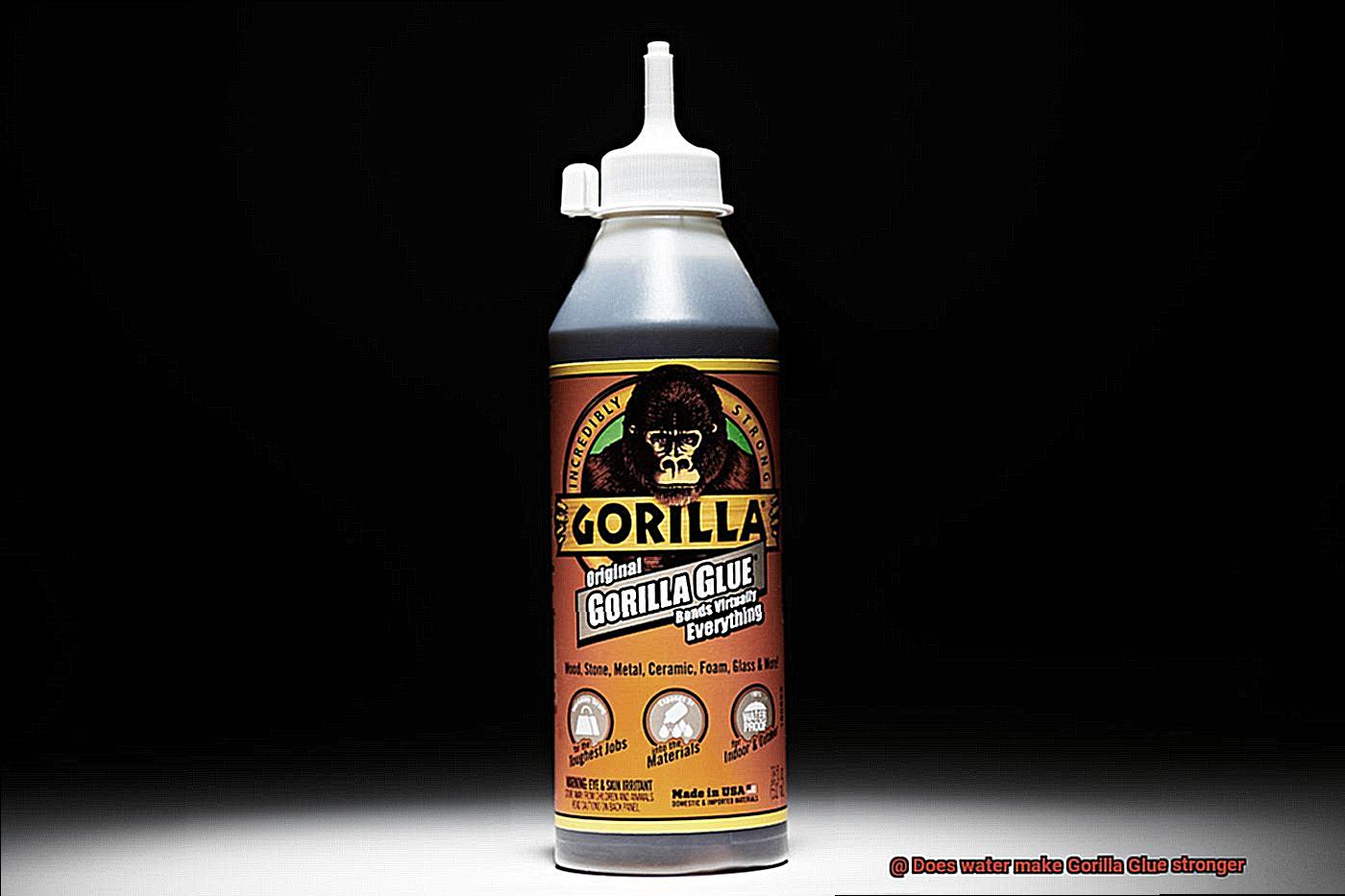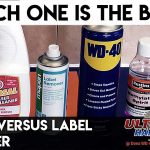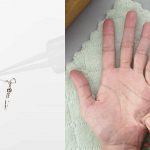We’ve all been there, tangled in a web of super glue, desperately trying to pry apart two objects that seem fused together for eternity. Whether it’s a DIY project gone wrong or an accidental spill, the struggle is real. But fear not, because here comes WD-40 to save the day. This multi-purpose spray has earned a reputation for being the ultimate problem solver. But can it really conquer the mighty grip of super glue?
In this blog post, we’re diving headfirst into this age-old question to uncover the truth about WD-40’s powers against stubborn super glue. Get ready to embark on a journey through the secret lives of these household staples as we unravel whether WD-40 is truly the magical elixir that can set your glued surfaces free. So buckle up and let’s find out if WD-40 is up to the challenge.
Factors that affect the effectiveness of WD 40 in removing super glue
Contents
- 1 Factors that affect the effectiveness of WD 40 in removing super glue
- 2 How does WD 40 remove super glue?
- 3 Step-by-step guide on using WD 40 to remove super glue
- 4 Precautions when using WD 40 to remove super glue
- 5 Materials where WD 40 may be effective in removing super glue
- 6 Materials where WD 40 may not be as effective in removing super glue
- 7 od surfaces
- 8 bric surfaces
- 9 Alternative methods for removing super glue from different materials
- 10 Tips for preventing accidental bonding with super glue
- 11 Conclusion
Accidents happen, and when super glue ends up where it shouldn’t be, many people turn to WD 40 for a potential solution. But does it really work? In this article, we will explore the factors that affect the effectiveness of WD 40 in removing super glue, providing you with the knowledge to approach this sticky situation with confidence.
Type of super glue:
Not all super glues are created equal. Different chemical compositions can impact how effectively WD 40 can dissolve or loosen the adhesive. Some super glues may be more resistant to solvents, requiring stronger solutions for removal.
Surface material:
The material on which the super glue is applied plays a crucial role. Porous surfaces like fabric or wood may absorb the glue, making it harder to remove completely.
On the other hand, non-porous surfaces like glass or metal allow for easier removal as the adhesive sits on top.

Duration of adhesive bonding:
The length of time that the super glue has been bonded to the surface affects its removal. Freshly applied super glue may be easier to remove as the adhesive has not fully cured and hardened.
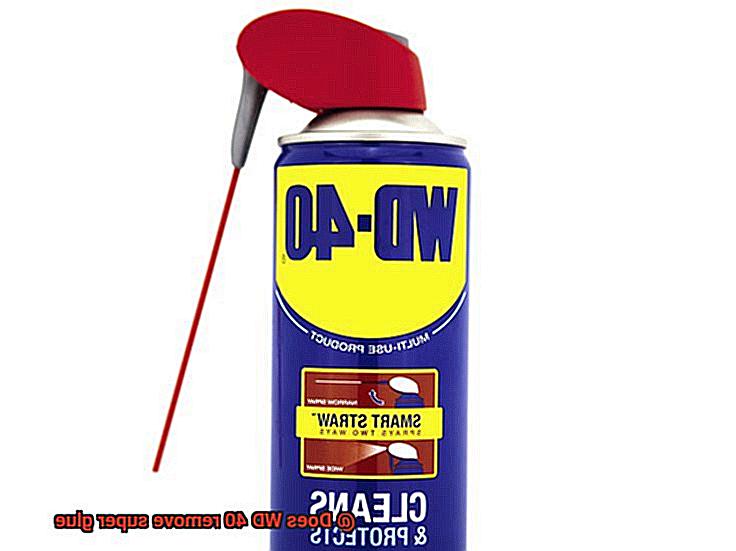
However, if the glue has been bonded for an extended period, it may require more time and effort to dissolve and remove.
Application method:
The way in which WD 40 is applied to the super glue can impact its effectiveness. Using a direct spray or applying it with a cloth or sponge provides better coverage and penetration compared to simply dabbing it on the adhesive. Direct contact enhances its ability to break down the bond.
Temperature and humidity:
Environmental factors such as temperature and humidity levels influence the effectiveness of WD 40 in removing super glue. Higher temperatures accelerate solvent action, while lower temperatures slow it down. High humidity levels aid in softening the glue, making it easier to remove.
Amount of WD 40 used:
The quantity of WD 40 applied to the super glue can impact its effectiveness. Using an adequate amount ensures sufficient coverage and allows the solvent to penetrate the adhesive thoroughly. Excessive use may not speed up the removal process and can lead to wastage.
Patience and technique:
Removing super glue with WD 40 requires patience and the right technique. Allowing sufficient time for the solvent to work on the adhesive is vital. Gently scraping or rubbing the glue with a cloth or sponge after applying WD 40 aids in loosening and removing the adhesive effectively.
How does WD 40 remove super glue?
We’ve all experienced the frustration of trying to remove super glue from surfaces. But fear not. There’s a superhero in the form of WD-40 that can come to your rescue.
WD-40, the trusty multi-purpose lubricant, is not only great for loosening rusty parts but also for tackling super glue mishaps. So how does it work its magic? Let’s dive into the science behind it.
Super glue, also known as cyanoacrylate adhesive, forms a strong bond when it comes into contact with a surface. This bond is created through a process called polymerization, where the molecules in the glue form long chains, locking it onto the surface. But WD-40 has a few tricks up its sleeve to break this bond.
The secret lies in WD-40’s composition. It contains solvents and lubricants like mineral oil and petroleum distillates that are specifically designed to dissolve or loosen various substances. When applied to super glue, these solvents penetrate the adhesive and start to break it down.
To use WD-40 for removing super glue, follow these simple steps:
- Apply a small amount of WD-40 directly onto the affected area.
- Allow it to sit for a few minutes, giving the solvents time to work their magic by softening the super glue.
- Gently scrape or peel off the softened glue using a plastic scraper or your fingernail. Be careful not to damage the surface beneath while scraping.
If the super glue is particularly stubborn or has been on the surface for a long time, you may need to repeat the process multiple times. However, always test a small, hidden area first to ensure that WD-40 is safe to use on your specific surface.
It’s important to note that while WD-40 can be effective in removing super glue from many surfaces, it may not work on all materials. Some surfaces can be sensitive to the solvents in WD-40, so it’s always a good idea to proceed with caution and follow the manufacturer’s safety instructions. And don’t forget to use WD-40 in a well-ventilated area.
Step-by-step guide on using WD 40 to remove super glue
In a world where sticky situations are all too common, fear not. We have the solution to your super glue woes. Prepare to be amazed as we unveil a step-by-step guide on how to use the mighty WD-40 to effortlessly remove super glue and save the day.
- Step 1: Gather the necessary supplies. Arm yourself with the tools of the trade: a trusty can of WD-40, a clean cloth, a plastic scraper, and if you prefer, a pair of gloves to shield your hands.
- Step 2: Prepare the area. Before diving into this adhesive adventure, take precautionary measures. Lay down a newspaper or a plastic sheet to safeguard surrounding surfaces from any potential mess. Ensure you’re working in a well-ventilated area, as our hero, WD-40, emits fumes that demand fresh air.
- Step 3: Apply WD-40 to the super glue. Unleash the power of WD-40 by spraying a generous amount directly onto the super glue. Witness its magic as it dissolves the adhesive properties, making the super glue easier to remove.
- Step 4: Let it sit. Patience is your ally here. Allow WD-40 to work its wonders for approximately five minutes. This precious time enables it to penetrate and weaken the bond between the glue and the surface.
- Step 5: Gently scrape off the super glue. Once those five minutes have elapsed, it’s time for action. Utilize a plastic scraper or even an old credit card to delicately scrape off the softened super glue. Exercise caution to avoid scratching or damaging the underlying surface.
- Step 6: Repeat if necessary. For those stubborn or thick layers of super glue that refuse to surrender, don’t lose hope just yet. You may need to repeat steps 3-5 to ensure complete eradication of all traces of super glue. Remember, patience is truly a virtue.
- Step 7: Clean and dry the surface. After triumphantly removing the super glue, it’s crucial to restore cleanliness and dryness to the scene. Take a clean cloth soaked in warm soapy water and wipe away any remnants left behind by the WD-40 and super glue. Thoroughly dry the surface to prevent potential damage or unwanted slipping.
Precautions when using WD 40 to remove super glue
When it comes to removing super glue, WD-40 is your trusty sidekick. But before you embark on your mission to banish that sticky situation, it’s important to take some precautions to ensure a safe and successful removal. Here are the essential steps to follow when using WD-40 to remove super glue.
First and foremost, make sure you’re working in a well-ventilated area. WD-40 can emit fumes that, although not harmful in small doses, can cause discomfort if inhaled for an extended period. So crack open a window or set up shop outside if possible. Breathe in that fresh air while you tackle the task at hand.
Next, protect those peepers. Super glue has a tendency to splatter or spray when being removed, so it’s vital to wear safety goggles or glasses. We don’t want any accidental contact with your eyes; trust me on this one. Shield those precious orbs and keep them safe from harm.
Now let’s talk about your skin. WD-40 can be quite harsh, especially with prolonged exposure. To avoid any unpleasant reactions, it’s best to wear gloves while using it. Nitrile or latex gloves will do the trick, providing a protective barrier between your skin and the magical elixir. Keep those hands soft and supple while you work your magic.
Here’s a crucial precaution: keep away from open flames. WD-40 is flammable, my friends, so please steer clear of any sources of ignition. No smoking, no candles, and definitely no experimenting near the gas stove. And let’s not forget to keep the area clear of any flammable materials too. Safety first, always.
Before you go all-in on that super glue removal mission, do yourself a favor and test the WD-40 on a small, inconspicuous area first. This little trial run will help you determine if there are any adverse reactions or potential damage caused by the WD-40 on the material or surface you’re working with. Better safe than sorry, right?
Always be sure to read and follow the instructions provided on the WD-40 product label. Different variants of WD-40 may have specific precautions or usage guidelines, so it’s essential to familiarize yourself with them beforehand. Knowledge is power, my friends, and it will lead you to a successful outcome.
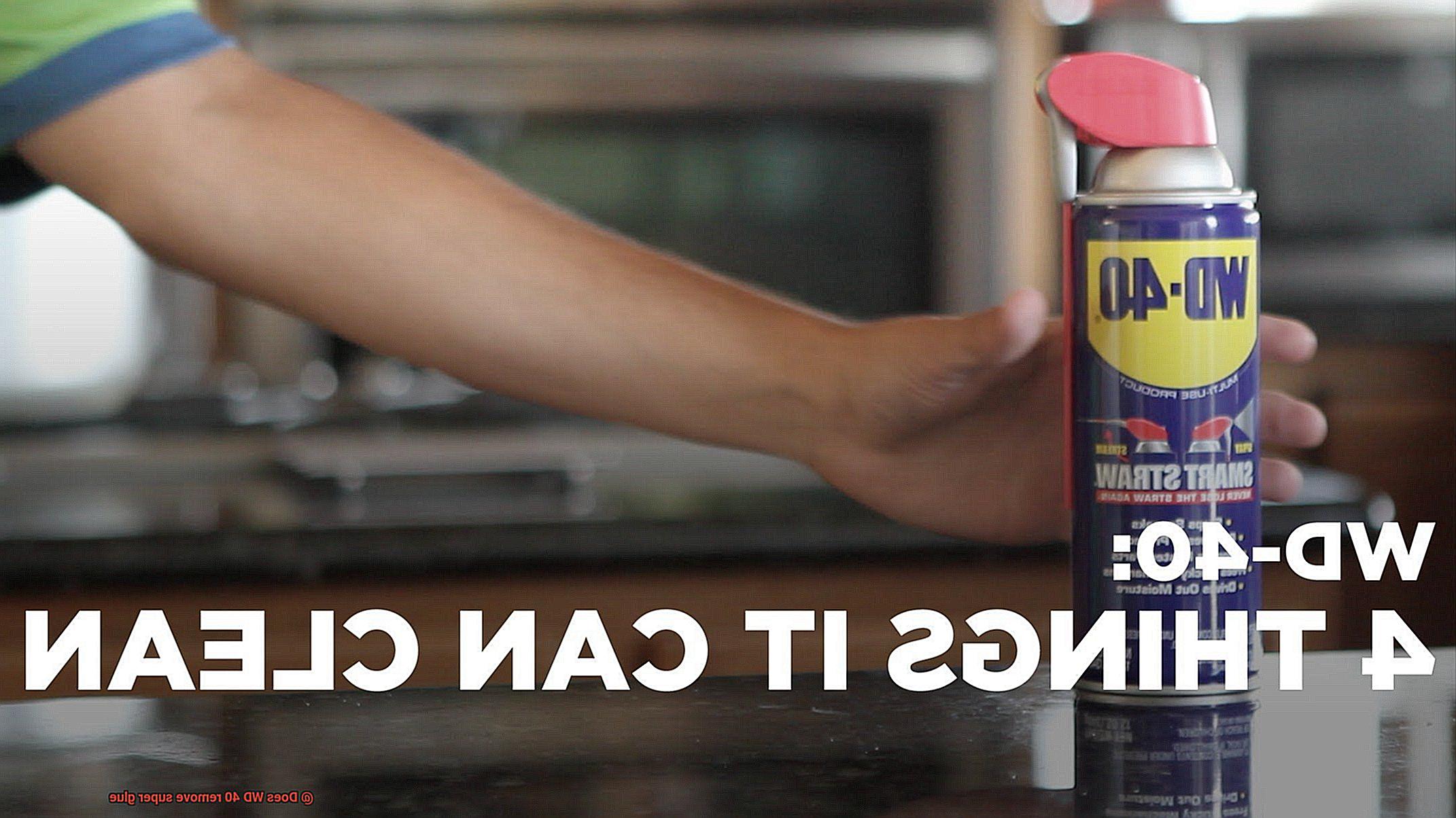
Accidents happen, so if you happen to spill some WD-40, clean it up immediately. WD-40 can create a slippery surface, especially on smooth or tiled floors. Grab some paper towels or rags and mop up that mess before anyone takes an unexpected tumble. Safety is a team effort, and we all need to do our part.
Materials where WD 40 may be effective in removing super glue
Accidentally, getting super glue on surfaces is a frustrating experience that we can all relate to.
Because there’s a secret weapon that can save the day: WD-40. This versatile household product is not just for squeaky hinges and rusty bolts; it can also work wonders in removing super glue from specific materials. Join me as we dive into the world of WD-40 and explore the materials where it can effectively banish super glue.
Metal:
WD-40’s superhero powers come to life when it encounters super glue on metal surfaces. Its magical formula penetrates the microscopic gaps between the glue and metal, weakening the bond. With a simple wipe or gentle scraping using a plastic scraper, you can easily bid farewell to the softened adhesive.
Glass:
Super glue loves sticking to glass, making it a real challenge to remove without causing damage. But fret not. WD-40 swoops in to save the day once again.
By applying a small amount of WD-40 and allowing it to sit for a few minutes, you’ll witness a softening of the adhesive.
With the help of a plastic scraper or soft cloth, you can gently scrape away the glue, leaving your glass surface as good as new.
Plastic:
Removing super glue from plastic surfaces requires caution, as not all plastics are compatible with WD-40’s solvents and oils. Before proceeding, perform a patch test on a small area to ensure compatibility. If all is well, apply WD-40 and gently wipe away the softened glue with a cloth. However, be mindful that certain plastics may be sensitive and prone to damage or discoloration.
Fabrics and Textiles:
Here’s where things get tricky. While WD-40 performs miracles on many surfaces, fabrics and textiles are not its best friends. The solvents in WD-40 can leave greasy stains, exacerbating the situation. In case of super glue spills on fabrics, it’s best to seek professional help or follow fabric manufacturer guidelines for specific instructions.
Materials where WD 40 may not be as effective in removing super glue
Imagine you’re in the midst of a DIY project, happily gluing together pieces of wood with super glue when disaster strikes. A glob of super glue lands on your favorite fabric, and panic sets in. How can you possibly remove that sticky mess?
Enter WD-40, the superhero of household products. With its magical formula, it can dissolve the bond between super glue and many surfaces, like metal, glass, and certain plastics. But before you go spraying it on every material in sight, let’s explore some scenarios where WD-40 may not be as effective in removing super glue.
Firstly, porous materials such as wood, fabric, and unfinished surfaces pose a challenge for WD-40. Super glue loves to seep into the tiny pores of these materials, making it difficult for WD-40 to penetrate and break down the bond. In these sticky situations, it’s best to seek professional help or follow fabric manufacturer guidelines for specific instructions.
Next on our list are rubber or silicone surfaces. Super glue bonds extremely well with these materials, and unfortunately, WD-40 may not be strong enough to dissolve the adhesive. To tackle this issue, specialized adhesive removers designed for rubber or silicone are your best bet.
Now let’s delve into glass or smooth surfaces. While WD-40 can work its magic here too, it may require more effort and multiple applications. The smooth surface makes it challenging for WD-40 to penetrate and dissolve the glue completely. So be prepared to put in some elbow grease.
Moving on to heat-resistant materials like certain plastics or metals – these tough cookies may not respond well to WD-40 as a super glue remover. Their ability to withstand high temperatures can render WD-40 less effective in breaking down the adhesive bond. Alternative methods should be explored in these cases.
We can’t forget about delicate or sensitive materials like electronics or painted surfaces. WD-40 should be used with caution here, as its ingredients may damage or discolor these materials. Always test a small inconspicuous area first before applying it to a larger surface.
Lastly, we have time-sensitive situations. While WD-40 can eventually dissolve super glue, it may take some time for the bond to weaken. So if you’re in a hurry and need immediate removal, using an alternative method like acetone or nail polish remover might be more effective.
od surfaces
Super glue is a marvel of modern invention, but when it finds its way onto unintended surfaces, it can quickly become a sticky nightmare. Fear not, my fellow warriors in the battle against glue mishaps, for I bring you the ultimate guide to safely removing super glue using the superhero of household products – WD-40. Grab your trusty can of WD-40 and join me on this thrilling adventure as we conquer sticky situations together.
Chapter 1: The Mighty Power of WD-40
- Unleashing the magic behind WD-40’s super glue-busting abilities
- Exploring the incredible versatility of this heroic product
Chapter 2: Knowing Your Surfaces
- Tackling od surfaces like wood, plastic, and more
- Conquering non-od surfaces such as metal and glass
- Mastering heat-resistant materials, delicate surfaces, and time-sensitive situations
Chapter 3: Step-by-Step Super Glue Removal
- Preparing the battlefield: priming the surface for the ultimate showdown
- Unleashing the power of WD-40 like a seasoned warrior
- The waiting game: letting WD-40 work its enchantment on the stubborn super glue bond
- The gentle art of scraping: skillfully removing softened super glue without leaving a trace
- Triumph in cleanliness: wiping away all remnants for a fresh start

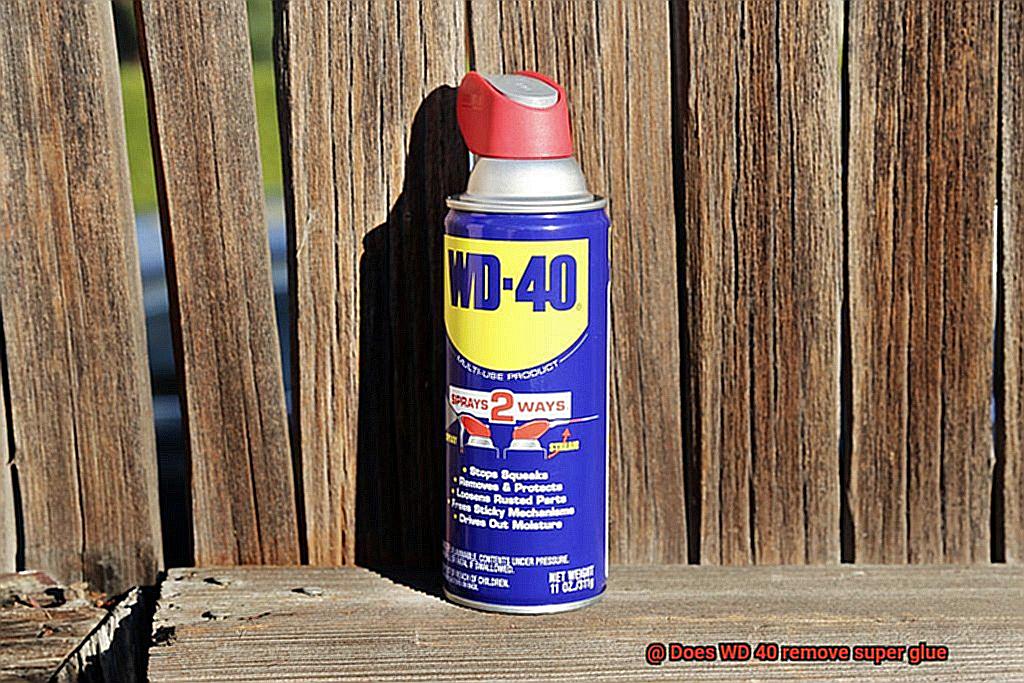
Chapter 4: Troubleshooting Tips and Tricks
- Facing off against relentless super glue with unwavering determination
- Alternative methods for specific surfaces that require strategic maneuvering
- Calling in reinforcements: seeking professional assistance when necessary
bric surfaces
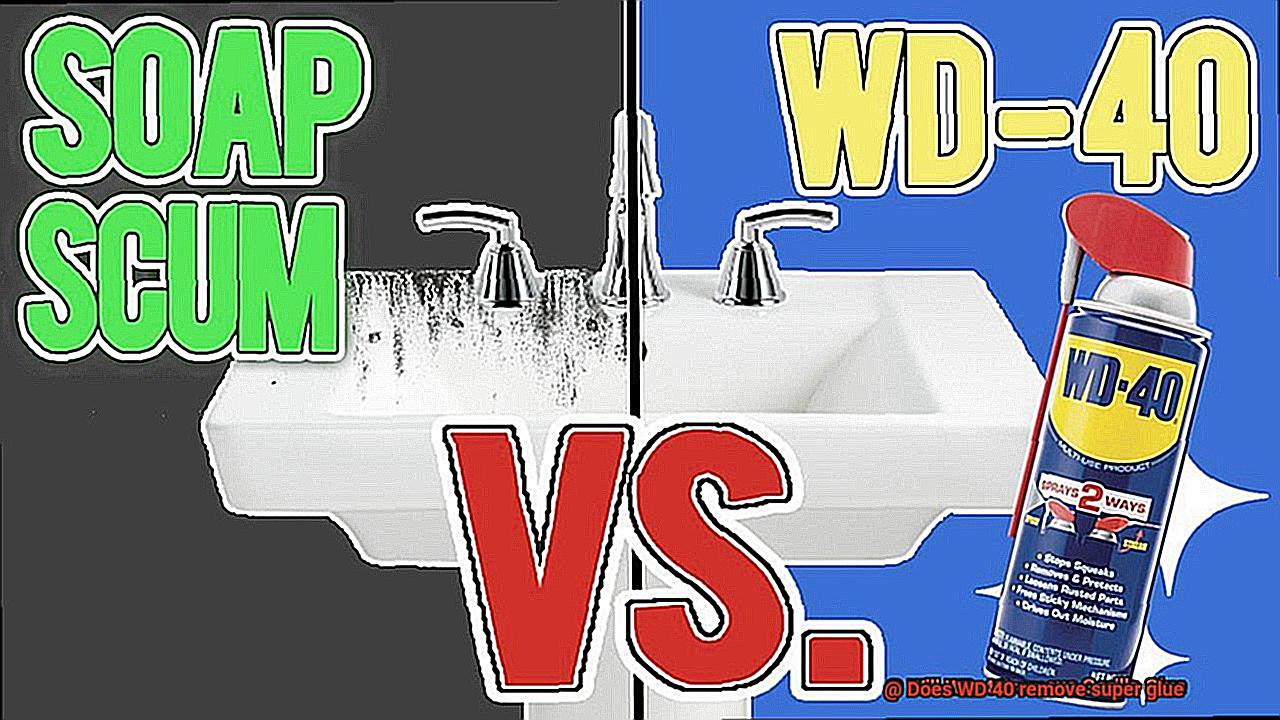
Unlocking the Power of WD-40: Conquering Stubborn Super Glue Stains on Brick Surfaces
Welcome, fellow DIY enthusiasts and curious readers. Today, we embark on an exciting journey to discover the superhero qualities of WD-40 when it comes to eliminating those pesky super glue stains from brick surfaces. Brace yourselves as we delve into the secrets of this magical formula and reveal how it can save the day.
Super glue, with its unrivaled adhesive properties, poses a formidable challenge when it finds its way onto brick surfaces. But fear not, for WD-40 is here to rescue us. With its unique formula, this household superhero can break down the bond between super glue and brick, making removal a breeze.
Before we dive into the exciting process of using WD-40 to remove super glue stains from brick, let’s remember that caution is key. Testing a small, inconspicuous area of the brick is crucial to ensure compatibility and avoid any potential damage or discoloration.
Now, let’s unveil our step-by-step guide to conquer those stubborn super glue stains:
- Protect your surroundings: Lay down a drop cloth or plastic sheeting to safeguard the area from spills or stains.
- Shake it up: Give your trusty can of WD-40 a good shake to ensure its powerful formula is properly mixed and ready for action.
- Precise application: Spritz a modest amount of WD-40 directly onto the super glue stain, avoiding oversaturation that could create an even messier situation.
- Patience is essential: Allow WD-40 to work its magic by letting it sit on the super glue for a few minutes. During this time, the formula will penetrate and loosen the adhesive bond.
- Gentle scrubbing: Armed with a soft-bristle brush or sponge, delicately scrub the treated area. This extra effort helps further break down the super glue and facilitates its removal from the brick surface.
- Rinse and repeat: Thoroughly rinse the area with water to eliminate any residual glue or WD-40. A hose or bucket of water and a trusty sponge are perfect for this step. If necessary, repeat the process until the super glue is completely eradicated.
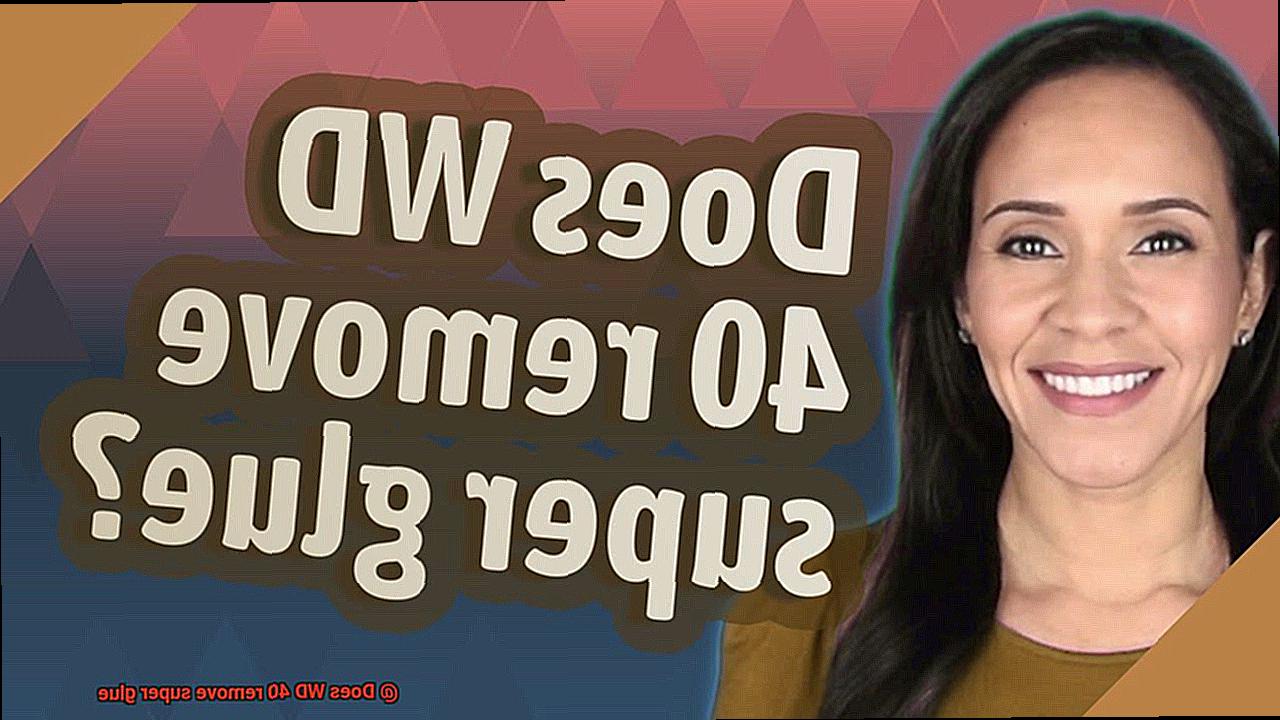
Take a moment to inspect the treated area for any lingering traces of super glue. If a few stubborn remnants remain, fear not. Simply repeat the WD-40 application process until your brick surfaces are restored to their former glory.
While WD-40 is a formidable ally in our quest to banish super glue stains from brick surfaces, it’s important to acknowledge that not all super glue brands and formulations are created equal. In some cases, professional assistance may be needed to tackle particularly stubborn or old stains.
Alternative methods for removing super glue from different materials
Picture this: you’re working on a project, and in a blink of an eye, super glue ends up on your hands and leaves an unwanted mark on your beloved surface. While WD-40 is often the hero in such situations, did you know that there are other powerful methods for removing super glue from different materials? Brace yourself as we delve into these alternative options and unleash the hidden potential of your household products.
Glass and Plastic Surfaces:
When it comes to glass and plastic surfaces, acetone or nail polish remover can work miracles. Prepare for the magic by applying pure acetone or an acetone-based nail polish remover to a cloth or cotton ball. Now, gently massage the affected area until the super glue surrenders its grip. Remember, a delicate touch is key here to avoid any damage.
Fabrics:
Time is of the essence when dealing with super glue on fabrics. Begin by scraping off any excess glue using a blunt knife or spoon. Then, introduce rubbing alcohol or isopropyl alcohol to the scene. Dab a cloth with this potent solution and gently pat the stained area. Avoid vigorous rubbing that might spread the glue further. Keep dabbing until the super glue succumbs to defeat. Rinse with cold water and launder as usual.
Wood:
Removing super glue from wood requires finesse to preserve its natural beauty. Start by scraping away as much glue as possible using a scraper or plastic card, ensuring minimal impact on the wood’s surface. Now, enter warm, soapy water onto the stage. Dampen a cloth with this gentle cleanser and caress the remaining glue with care. If needed, enlist vinegar or lemon juice to dissolve the adhesive properties of the super glue. Apply a dab of these acidic heroes to a cloth and softly rub until the glue surrenders.
Metal:
Metal surfaces can handle a more daring approach to defeat super glue. Introduce a heat gun or hairdryer to the battleground, warming up the glue and making it easier to scrape off with a plastic card or scraper. Alternatively, summon the powers of white vinegar or lemon juice as they dissolve the glue’s stronghold. Apply a small amount of these acidic warriors to a cloth and gently rub until the super glue loosens its grip. Rinse with water and ensure thorough drying.
Tips for preventing accidental bonding with super glue
Accidental bonding with super glue can be a frustrating and messy experience. The strong adhesive properties of super glue make it difficult to remove once it has bonded to surfaces. However, by following some simple tips and precautions, you can minimize the chances of getting stuck in a sticky situation. In this article, we will explore effective strategies for preventing accidental bonding with super glue.
Read and Follow Instructions:
To prevent accidental bonding, it is crucial to carefully read and follow the instructions provided by the manufacturer. Each brand of super glue may have specific guidelines for application, drying time, and removal. By adhering to these instructions, you can ensure that you are using the product correctly and reducing the risk of accidental bonding.
Wear Protective Gloves:
Wearing protective gloves, such as latex or nitrile gloves, can provide a physical barrier between your skin and the super glue. This prevents accidental bonding if any drops of glue come into contact with your hands. Additionally, gloves protect your skin from potential irritation or allergic reactions caused by prolonged exposure to the adhesive.
Use a Barrier:
Placing a barrier between the surfaces you are working on can help prevent accidental bonding. For example, when working on a tabletop or countertop, cover it with plastic wrap, wax paper, or aluminum foil before applying super glue. This creates a protective layer that prevents the glue from directly contacting the surface and bonding unintentionally.
Work in a Well-Ventilated Area:
Super glue contains chemicals that may release strong fumes during application. These fumes can irritate the eyes, nose, and throat if inhaled in large quantities. To minimize the risk of accidentally inhaling these fumes, work in a well-ventilated area. Open windows or use fans to improve air circulation and reduce the concentration of fumes around you.
Use Small Amounts of Glue:
Using excessive amounts of super glue can increase the chances of accidental bonding. Apply small, controlled amounts of glue to the desired surface. This reduces the risk of spills and drips and allows for easier cleanup if any accidental bonding occurs.
Keep Surfaces Clean and Dry:
Before applying super glue, ensure that the surfaces you are bonding are clean and dry. Dirt, oil, or moisture on the surfaces can interfere with the adhesive properties of the glue and result in weaker bonds. Thoroughly clean and dry the surfaces beforehand to ensure optimal adhesion and reduce the likelihood of accidental bonding.
Store Super Glue Properly:
Proper storage of super glue is essential for preventing accidental bonding. Always tightly seal the cap or lid after each use to prevent air exposure, which can cause the glue to dry out and become less effective over time. Store super glue in a cool, dry place away from direct sunlight or heat sources, as excessive heat can accelerate the drying process.
nv1v2ZGdPX4″ >
Conclusion
WD-40 is a powerful solution that can effectively remove super glue.
It works by breaking down the adhesive properties of the glue, allowing you to easily peel it off surfaces. This versatile product is not only great for lubricating and protecting various materials, but it also comes to the rescue when you find yourself in a sticky situation with super glue.
So, if you accidentally get super glue on your hands, furniture, or any other surface, reach for WD-40 and watch as it effortlessly dissolves the bond.

